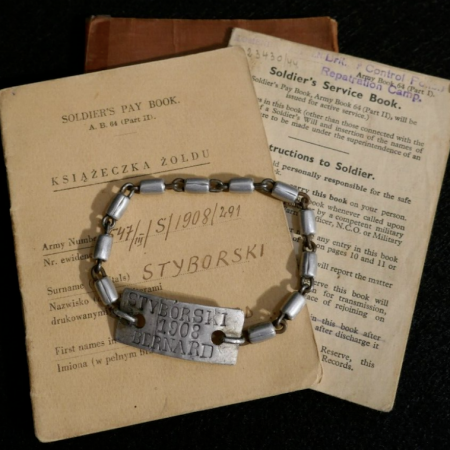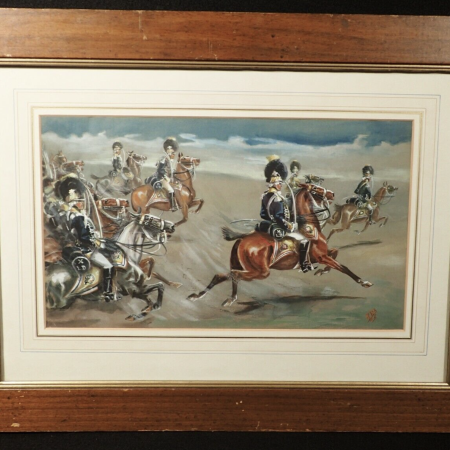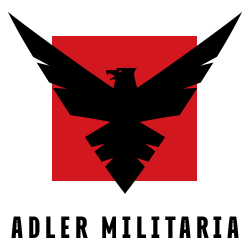Showing 658–666 of 1332 resultsSorted by latest
-

WWII Free Polish Army – Service & Pay Book – Armed Forces West – Styborski – Soldier’s ID Bracelet – Super Rare
Rare Original WW2 Free Polish Army Armed Forces West Soldier’s ID Bracelet ‘STYBORSKI 1908 BERNARD’ From Aircraft Aluminum and a Section of K98 Cleaning Chain. Soldier’s Service Record Army Book 64 in Polish & Pay Book, all pieces to Bernard Styborski 1908 (Year of Birth), Called into Service 1944. The formations, loyal to the Polish government-in-exile, were first formed in France and its Middle East territories following the defeat and occupation of Poland by Germany and the Soviet Union in September 1939. After the fall of France in June 1940, the formations were recreated in the United Kingdom. Making a large contribution to the war effort, the Polish Armed Forces in the West was composed of army, air and naval forces. The Poles soon became shock troops in Allied service, most notably in the Battle of Monte Cassino during the Italian Campaign, where the Polish flag was raised on the ruined abbey on 18 May 1944, as well as in the Battle of Bologna and the Battle of Ancona (both also in Italy), and Hill 262 in France in 1944. The Polish Armed Forces in the West were disbanded after the war, in 1947, with many former servicemen forced to remain in exile. https://www.youtube.com/watch?v=MMlrL2x173w
-

WWII Imperial Japanese Navy – Aviation Type I Directional Compass – Tokyo Instrument- Very Rare
WW2 Imperial Japanese Navy Aviation Type I Directional Compass, Tokyo Instrument Wonderful & Rare Original WWII Imperial Japanese Navy Aviation Type I Directional Compass Manufactured by ‘Tokyo Aviation Instrument Company’ NAVY TYPE I with Imperial Japanese Navy Anchor Inspection Mark; Shock Cradle Mounted and 6 Inches Diameter. Rare Item
-

Charge of The 10th Light Dragoons 1790 – Gouache (Watercolor) by George Henry Boughton RA 1905 – Original Painting 10.25 x 17.75″ (20 x 27″ framed) – Signed in Monogram and Dated 1905 – Title to Reverse ‘Charge of The 10th Light Dragoons 1790’
Charge of The 10th Light Dragoons 1790, Gouache (Watercolor), George Henry Boughton RA 1905 Original Painting 10.25 x 17.75″ (20 x 27″ framed) Signed in Monogram and Dated 1905 Title to Reverse ‘Charge of The 10th Light Dragoons 1790’. George Boughton passed away January 19, 1905 – this wonderful original piece was completed and signed in the last weeks of his life and was perhaps his last completed painting. This exceptional original work remains in fine condition with a vintage frame which is in good condition. The paper backing is separating from the frame edges and there are some scuffs and nicks to the wood as photographed. A fine subject matter for George Boughton who painted numerous pieces depicting landscapes of England, Brittany, and The Netherlands but also depicted American Colonial History. In addition to being a painter Boughton was also an exceptionally accomplished illustrator. He illustrated Washington Irving’s ‘Rip Van Winkle’ and ‘History of New York’ plus Nathanial Hawthorne’s ‘Scarlet Letter’ amongst others. Most of Boughton’s Paintings were small sized and expressed sentimentality in soft muted tones; additionally, most of his works were of rural and rustic figures. This painting is unique in that it is bold, regal, and robustly executed. Boughton is held in prominent museums and collections. Vincent Van Gogh, who lived in London 1873 to 1875, was impressed by Boughton’s painting Godspeed! Pilgrams Setting Out For Canterbury. Then working as a minister he gave a sermon that was inspired by the painting, and wrote about it to his brother Theo. The Boughton painting is now part of the collection of The Van Gogh Museum in Amsterdam, Netherlands. He met and knew both James Whistler and Henry James. A prolific artist with an impressive history and career. This work is magnificently executed and will make a fine addition to any advanced collection, library, or home. Provenance: Long held by a Palm Beach Estate. Rare George Henry Boughton RA (4 December 1833 – 19 January 1905) was an Anglo-American landscape and genre painter, illustrator, and writer. Born in England lived in New York City and passed in England. Member National Academy of Design & The Royal Academy. Listed in Fielding’s Who Was Who in American Art & Susan Theran’s Fine Art Price Guide.
-

WWII German Wehrmacht Soldbuch – Obergefreiter Merkel – Grenadier Regiment 693 (339. Infanterie-Division) – Infantry Assault Badge – Wounded in Russia – Lost Family due to Allied Bombing of Kassel 1944 (SOLD)
Issued on the the 12th of September 1940 in Kassel with Landesschützen Ersatz Batl 9 to Albert Merkel from the Kassel area. He was born in 1909 into a protestant family. His next of kin was his father living on Hermann-Göring Street. Unit he spent time with: Infanterie Regiment 654 – Landeschützen Batl 622 – 1.1941 – Guarding POWs. Infanterie Regiment 691 – 5.1941 Grenadier Regiment 691/693 – 1943/44 – 339. Infanterie-Division – Heeresgruppe Mitte – Russian Front – Grenadier Regiment 135 – Destroyed Page 14 – Notes that on the 26.1.1945 – Merkel was found after his unit was destroyed. Führergeschenk – 23.1.1944, Issued an Iron Ration – 22.7.44 Issued a Rifle in 1941, with Bayonet. Wounded won the 8.2.1945 – Hospital – 26.5.1944 , Bad Höhenfels moved with hospital train to Bad Mergntheim. Medals: Eastern Front Medal – 23.8.1943 – IR693 Infantry Assault Badge in Silver – 24.10.1943 – IR693 – Middle Sector Russian Front Black Wounds Badge – 26.5.1944 – Wounded due to enemy action Admitted leave September 1944 for around two weeks, because his home house was completely destroyed by Allied Bombing Raid, killing his family members. Last Comments: A nice Soldbuch, clean cover and with combat entries. Nice Uniformed picture. Sad strory with his family getting killed so close to the end of the war.
-

WWII German Wehrmacht Soldbuch – Obergefreiter Jonas – Schwere Heeres Panzer Jäger Abt 657 – 212 Volks Grenadier Division – Ardennes Battle 1944/45 fighting against US 10th Armoured Division – Captured in Donkholz/Doncols (Luxemburg) by US Troops of the 90th Inf Div in January 1945 – POW Papers (SOLD)
A very nice Soldbuch, first issue September 1944 issued in Berlin, Potsdam to Kurt Joans born in 1916 in Berlin Eberswalde. Issued by a anti tank/tank hunter replacement unit in Potsdam. Jonas next of kin was his mother in Eberswalde, Berlin. Jonas was issued a full kit on November 1944, as well as a Pistol, by Schwere Heeres Panzer Jäger Abt 684, and deployed with Schwere Heeres Panzer Jäger Abt 657. A lovely entry into the cover page and page 8 – Ausbildungskommando 8.8cm Pak – Meaning he took part in training on the 8.8cm Pak Gun. A complete list/Order of creation for the unit can be seen here: https://www.lexikon-der-wehrmacht.de/Gliederungen/HeeresPzJAbt/Gliederung.htm Armed with 8.8cm Heavy Motorised P.A.K, according to one book (Advance and Destroy: Patton as Commander in the Bulge, By John Rickard) it seems they had 16 Panzer Jäger (unknown what type of armoured vehicle). They were to fight under, the 212 Volksgrenadier Division in the Battle of the Ardennes 1944/45. The 212. Infanteriedivision was destroyed in August 1944 in Lithuania and these survivors were combined with the 578. Volksgrenadierdivision at Schieratz in Poland. Keeping with the make-up of the original division most of the personnel were from Bavaria and were most young men, many of who were just seventeen years old. In November 1944 the division was moved west and joined the Seventh Army across the Sauer from Echternach. It was commanded by Generalleutnant Franz Sensfuss. It was at full-strength and its morale was high. However, like many of the other Volksgrenadierdivision is only had a portion of it armoured vehicle allocation. Just five StuG assault guns were available. It also only had two of its three infantry regiments available at the start of the Ardennes offensive as the third had been put in the Seventh Army reserve. The initial attacks on 16 December 1944 went well from Echternach towards Berdorf, Dickweiler and Osweiler. The Volksgrenadiers were well behind the American lines before the command of the US 4th Infantry Division were able to react. Echternach was finally taken on 17 December after Sensfuss personally led an assault by the 212. Füsilier Bataillon. The division also took Berdorf the same day, forcing a task force of the US 10th Armoured Division out of the village after bitter fighting. As more units of Patton’s US Third Army began to arrive the Volksgrenadiers were forced over to the defence. They hung on to their gains, but were eventually forced to retire and were back on their start positions by the end of January 1945. However, even with companies reduced to 25 to 30 men they continued to fight stubbornly. They defended the West Wall in February against Patton’s forces. The small kampfgruppe they had become didn’t surrender until May 1945 in Baumholder, Bavaria. Final Comments It seems Jonas, was captured by the 90th Infantry Division of the US Army in January of 1945 in the town of Doncols (German: Donkholz), stated on the POW papers that Jonas is a MG Gunner. This coincided with his weapons issued, he was only given a Pistol as per the regulations for a MG Gunner. I was unable to find out what they were armed with. But it seems it must have been an 8.8cm on some sort of carriage. A very nice Ardennes/Luxemburg related Soldbuch. Video below shows German POWs captured by the 90th Infantry Division USA in January 1945. Could be that Jonas is standing in this group of POWs.
-

WWII Kriegsmarine Soldbuch – Matrosen Obergefreiter Pardon – Torpedofangboot F7 – Kurland Evacuations 1944/45 – Last Ditch April 1945 – Festungs Pak Abt 101 (Sold)
This nice little KM grouping to Helmut Pardon, Soldbuch was issued in 1941 and he was assigned to U-Boat Training in Pillau. Although due to the course of the war Pardon would serve on Torpedofangboot (Torpedo Catch Boat) F7 – his Feldpost numbers were mostly obscured although I was able to find it out (29875). In 1944/45 this boat was on active duty in the Baltic area, they were assigned to evacuations to the trapped Army Groups in Kurland. The boat is pictured a few times in his personal photos which show him swearing his oath to Germany/AH. On the first of April 1945, he was assigned to: Festungs Pal Ersatz und Ausbildungs Abt 101 (A) – this unit was deployed all over the last sections of the front still in combat. Its been researched skilfully here: http://richard.tom-goebel.de/berlin-1945/festungs-pak Last Comments: We will never know if Pardon was onboard a UBoat or in the Battle of Berlin. Both are dead ends, but what we know is that he was for sure on the Kurland Coast during the battles. A nice KM Last Ditch Soldbuch. Comes with his 1937 Landjahr ID Booklet with a photo of him in Hitler Youth Uniform.
-

WWII German Wehrmacht Soldbuch – Prisoner of War Grouping – St Marie du Mont – Fahnenjunker Blatter – Grenadier Regiment 212 – Close Combat Days Castle Stanca Romania 1944 (SOLD)
It is obvious he has had problems with his Soldbuch when he arrived in the POW Camp in St Marie du Mont (France), he was then processed at Cherbourg in July 1945. It seems he was then interned in PGA (French POW Camp) Number 131 at Clermont Ferrand still in 1947. Photos of this camp can be found online. The French Army in Normandy made him a copy of the front page of his Soldbuch, he must have had it in bad condition and they added it to his Soldbuch. Walther Blatter was born in the area of Saarbrücken, Germany in 1924 into a protestant family. He worked as a postal assistant before the war. He was unmarried and his next of kin was his father at their home address in Sarrbrucken. Frontline Units: Grenadier Regiment 886 Grenadier regiment 212 Awards Page 4.5.43 – Wounds Badge GR212 5.43 – Iron Cross Second Class – 79 ID 16.6.1944 – EKI – 79 ID 22.6.1944 – Infantry Assault – GR212 13.6.1944 – Wounds Badge in Silver 18.6.1944 – Kuban Schild There is a possibility that both the EK2 and the EK1 and Kuban are forged, wartime or after the war we will not know. But again with further research could be possible he has the both EKs. Close Combat Days – 28.4.1944 – Cuza Voda, Rumania 29.4.1944 – North East of Cuza Voda, Romania 30.5.1944 – Attack on Stanca Heights 31.5.1944 – Night Attack on Castle Stanca 24.3.1944 – Counterattack (?) Assault Days 28.4.1944 – Cuza Voda 30.5.1944 – Attack at Castle Stanca, Romania 31.5.1944 – Night attack at Castle Stanca 24.3.1945 – Counterattack (?) Wounding 8.1943 – Contracted Malaria – this injury would bug him even during the course of another wounding. 29.4.1944 – 31a and 31b – Bullet stuck in his left upper leg, and shrapnel wounds on the buttocks. Issued – Compass and Full combat Gear Final Comments A little messy grouping of pocket litter of a POW Processed in Normandy.
-

WWII German Wehrmacht Soldbuch – Pionier Detmer – Grenadier Regiment 941 (353 Inf DIv) – Captured on Western Front 1944 – POW Papers – Siegfried Line 1944/45 (Hold)
A nice Soldbuch issued to Hermann Detmer in Höxter 1944 with a Pioneer Unit. Detmer was assigned to a few units conducting Pionner work, focusing on bridge building. In 1944, he was assigned to Grenadier Regiment 941 (353 Inf Div) Issued with a Iron Ration in August 1944 and a rifle on the 13th of June 1944. Meaning sometime after September of 1944 he was deployed with Grenadier Regiment 941. Between December 1944 and January 1945, the 353rd Infantry Division operated as part of the LXXXI Army Corps at the Westfall defensive fortifications (Allied parlance: “Siegfried Line”), where it launched a major counterattack on 2 December, which was eventually beaten back by U.S. artillery.[5] The 353rd Infantry Division was eventually trapped in the Ruhr Cauldron, where it went into American captivity around April 1945.[1] The division’s final commander was Colonel Kurt Hummel, who assumed command on 15 February 1945 Final Comments: Detmer was captured by Allied Troops in late 1944. He was held in France as a POW according to his POW Papers. He was still a POW in 1946, a further paper shows he was working at the POW Barracks.
-

WWII Soldbuch Wehrmacht – Uffz Steiner – Infanterie Regiment 134 – 44. Reichsgrenadier-Division Hoch- und Deutschmeister – Gustav Line Italy 1944 – Battle of Vienna 1945 (Sold)
Soldbuch issued in September 1939 to Rudolf Steiner born in 1919, he was a farmer before he joined the Army. He joined Infantry Regiment 134 in 1941. Fighting for a very short time in Russia 1941/42. In 1942 he was sick the whole year due to an internal problem. He was back with his frontline unit again early in 1944 around mid 1944. He fought the summer of 1944 on the Gustav Line in Italy. But by January of 1945 he again admitted to hospital with 25 (Skin Issue) and 18 (Pneumonia). Spent the rest of the war in Hospital till the 3rd of April 1945, he was sent to the Frontleitstelle (Front Direction / Recruitment) in Vienna 1945 Medals: Eastern Front Medal Infantry Assault Badge Final Comments He likely took part in the battle for Vienna as he was found fit for duty again and sent to the front. Really nice to find an Italy Soldbuch these days, getting harder.




